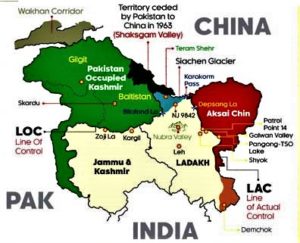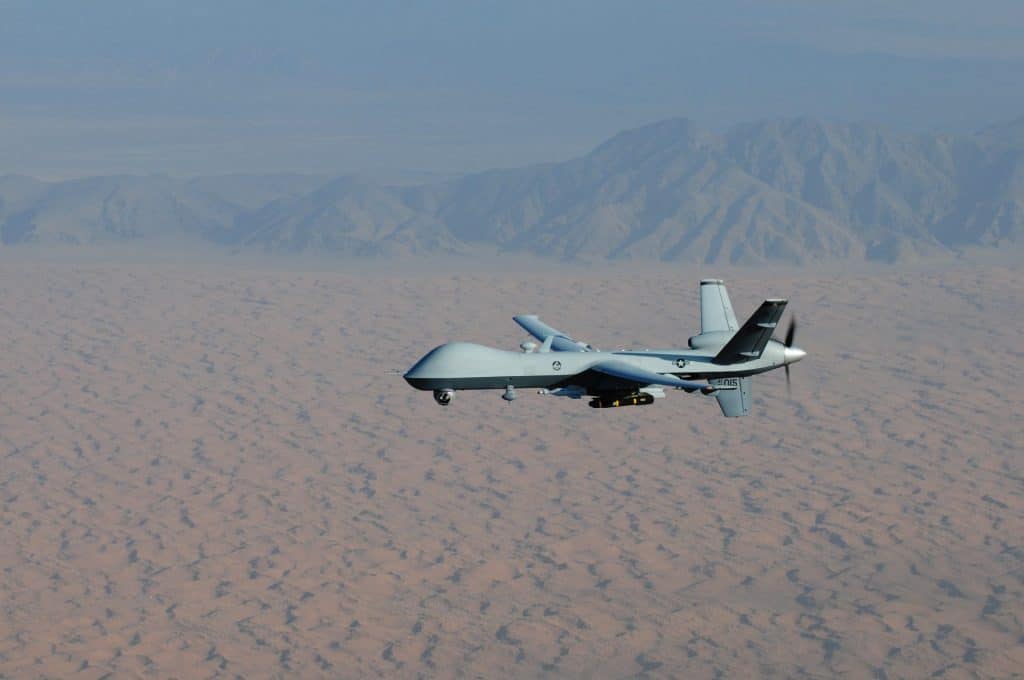First Published in Eurasia Review, 30 June 2021
Amid repeated detection of drones—Unmanned Aerial Systems (UAS)—in the Union Territory of Jammu and Kashmir, and hours following a drone attack on the Indian Air Force (IAF) base at Jammu airport, India signalled the alarm about the likely use of weaponised UAS by non-state actors for terror activities. A high-level meeting was held in New Delhi on Tuesday evening chaired by Prime Minister Narendra Modi with Defence Minister Rajnath Singh, Union Home Minister Amit Shah and National Security Advisor Ajit Doval to take stock of the situation. Reports say that they discussed the emerging challenges in the security architecture of the country and the possible measures to equip the Indian military with advanced systems to cope with the UAS threat.
India also raised the new security threats posed by UAS in a meeting of the UN General Assembly. V. S. K. Kaumudi, Special Secretary (Internal Security), Ministry of Home said: “Being a low-cost option and easily available, utilisation of these aerial/sub-surface platforms for sinister purposes by terrorist groups such as intelligence collection, weapon/explosives delivery and targeted attacks have become an imminent danger and challenge for security agencies worldwide.” He said that “The possibility of the use of weaponised drones for terrorist purposes against strategic and commercial assets calls for serious attention by the member states. We have witnessed terrorists using UAS to smuggle weapons across borders.” Mr. Kaumudi said “the transborder nature of this threat calls for collective and unified action by the international community, without any excuse or exceptions, ensuring that those countries which provide safe havens to terrorists should be called out and held accountable.” His remarks came at the Second High Level Conference of the Head of Counter-Terrorism Agencies of the Member States in the General Assembly.
It was in the early hours of Sunday that the technical area of Jammu Air Force Station was attacked using two low-intensity improvised explosive devices (IEDs), reported to have been dropped from two drones. Two IAF personnel were injured in the explosions. The Jammu and Kashmir police chief called it “a terror attack.” Security officials suspect that Pakistan-based terrorists would have used drones for attack—considering the short aerial distance (14 km) between the Jammu airbase and the border. Police and other agencies, including the National Investigation Agency (NIA) began to coordinate the probe to unearth the plan behind the attack.
The involvement of Pak-based outfits was suspected due to other related incidents. Even as investigation was underway following the drone attack, a suspected man having links with the banned Lashkar-e-Taiba (LeT) was apprehended who possessed some improvised explosive device. On Monday, two Jaish-e-Mohammad (JeM) militants were involved in the killing of a special police officer (SPO), Fayaz Ahmad, his wife and daughter in Pulwama district of J&K. A report in The Statesman said that a few hours after the attack at Jammu, there was another attempt to target two strategic military stations, Kaluchak and Ratnuchak, with drones, in early morning of Monday. However, it was foiled by Quick Reaction Teams (QRTs) that fired at the drones.
 L
L
Line of Control
New Delhi’s Outreach in J&K
The drone attack came just three days after the Union Government initiated the first major political outreach since the abrogation of Article 370 of the Indian Constitution and the division of J&K state into two Union Territories in August 2019. The meeting of the Prime Minister with 14 political leaders, including that of People’s Alliance for Gupkar Declaration (PAGD)—an umbrella alliance of mainstream political parties in Jammu and Kashmir seeking the restoration of the special status of the erstwhile state—was held on 24 June. At the meeting, Prime Minister Narendra Modi laid special emphasis on two main issues–working together to take democracy to grassroots in J&K and cooperation to take all-round development in J&K to all communities and areas. Modi himself called this meeting as “an important step in the ongoing efforts towards a developed and progressive J&K, where all-round growth is furthered.” As the democratic process—of consultation with the political parties—was underway, there were speculations about some attempts, as in the past, to derail the efforts. The banned terror outfits, who were playing hide and seek in J&K for some time, were feared to have come back amid the pandemic.
There were reports, a few days ago, that the Core Group consisting of top officials of civil administration, intelligence agencies and security forces had a meeting in Srinagar to discuss measures to offset the changing strategy of terrorists—of attacking soft targets in J&K. The Core Group had apparently considered inputs brought in about the Line of Control and hinterland security situation. The officials, however, stated that there were indications of heightened activity in the last two months. The intelligence and security agencies had initiated surveillance and monitoring regarding cross-border smuggling of narcotics and weapons. In January this year, the Border Security Force (BSF) had detected some cross-border tunnels on the India–Pakistan boundary for infiltration of terrorists and drones for dropping arms and ammunition on this side of the international border. The Statesman reported that Pakistani agencies had started building tunnels and using Chinese drones to bypass the border fencing by India that had helped controlling infiltration of terrorists and also dumping arms and ammunition for them by the ISI and Pakistani military.
Why Drones Matter?
Years back, many defence experts and think tanks had warned that drones were becoming increasingly common in warfare, especially when their operating costs began to come down. Over years, many state and non-state actors have shown enormous interest in the production and stockpile of UAS. By March 2020, more than 100 nations had procured military drones, and nearly 40 possessed, or were in the process of purchasing weaponised drones. Around “35 states are now believed to own drones in the largest and deadliest class of these weapons, and at least 20 non-state actors have acquired weaponized drone technologies,” according to a report. During the last six years, the U.S. and as many as 10 other countries (Egypt, Israel, Iraq, Iran, Nigeria, Pakistan, Saudi Arabia, Turkey, the United Kingdom, and the UAE) were reported to have run drones for the use of force, such as in targeted killings. The large-scale use of drones and their proliferation across the world thus pose a new generation threat to international security.
The civilian casualties of drone attacks also caused much alarm. A Bulletin of the Atomic Scientists report quoted saying that “more than 80 per cent of the total number of civilian deaths in Yemen from 2009 to 2014 were caused by drones, according to research conducted by the nonprofit research and analysis organization CNA.” Studies say that damage caused by armed drone strikes goes beyond killings. A huge number of civilians also get maimed. In her latest report, the UN Special Rapporteur on Extrajudicial, Summary, or Arbitrary Executions, Agnes Callamard, argued that the world had entered a ‘second drone age’ “marked by the uncontrolled proliferation of armed drones, the most advanced of which are stealthier, speedier, smaller, and more capable of targeted killings than a previous generation.”
Many countries consider military drones as significant defence assets. In UASs there is no risk of losing any human being to the adversary. Moreover, drones lessen the time for operation and can attack with greater precision. They also make it difficult to identify the agents of an attack. UASs were widely used in Syria, Libya, and in the Nagorno-Karabakh conflict in which Azerbaijan deployed Turkish and Israeli drones to offset the Armenian air defences.
The U.S. is considered to be the biggest exporter of arms to the Middle East and has a stock of the most sophisticated military drones in the world. But Washington has seldom promoted their export (however, Britain, France, and Italy did procure US armed drones for their inventories). The other major exporters of armed UASs are Israel and China. Some countries in the Middle East appeared to be the major recipients of the Chinese CH-4 and Wing Loong 1 and 2 drones. Israel is also reported to have become a potential exporter of military drones to the Middle East. However, as another report says, while Israel continues to be the number one exporter of drones in the world (supplying 56 countries), above both the United States (which exports to 55 countries) and China (37 countries), its drone exports to the Middle East were not substantial. The continuing conflict situation and distrust in the neighbouring countries prevent Israel from selling military drones to Arab states. But with the establishment of diplomatic relations with the UAE, Bahrain, Sudan, and Morocco, the export of Israeli drones to the Gulf regimes cannot be ruled out.
China has also become one of the top suppliers of armed drones. Estimates of 2019 indicated that 32 countries had at least one drone made in China, including Egypt, which operated 60 such drones; Saudi Arabia, which had 70; and the UAE, which owned 40. Reports also suggested that China even used ‘drone diplomacy’ to reinforce its Belt and Road Initiative with large scale drone exports. According to Zachary Kallenborn, “Countries are already putting together very large groupings of drones. In India’s recent Army Day Parade, the government demonstrated what it claimed is a true drone swarm of 75 drones and expressed the intent to scale the swarm to more than 1,000 units. The US Naval Postgraduate School is also exploring the potential for swarms of one million drones operating at sea, under sea, and in the air. To hit Nagasaki levels of potential harm, a drone swarm would only need 39,000 armed drones, and perhaps fewer if the drones had explosives capable of harming multiple people. That might seem like a lot, but China already holds a Guinness World Record for flying 3,051 pre-programmed drones at once.” A research report on Chinese drone exports published by Foreign Affairs says that way back in 2011, China had initiated negotiating with countries such as the UAE and Pakistan to sell them armed drones.
What worries many today is UAS proliferation among the non-state actors. There were reports that rebel groups across the world have started amassing drones—from South America to West Asia—and they have deployed commercially accessible drones to survey enemy locations. Jihadi outfits such as ISIS were reported to have equipped these armed drones and used them in fighting. The use of drones for targeted killings also triggered controversies. For instance, the assassination of Iranian General Qasem Soleimani and others by the United States in Iraq had worsened U.S.-Iranian relations.
In fact, India has already anticipated the threats from armed drones from both state and non-state actors, given the worsening relations with both Pakistan and China. The Ministry of Home Affairs had on 10 May 2019 issued comprehensive Standard Operating Procedures (SOPs) “for handling the threat from drones and other sub-conventional aerial platforms in the country. They were “issued to defence forces and other security agencies of the country and the States, who are maintaining utmost vigil against hostile or rogue drones.” India also brought in Unmanned Aircraft Systems (UAS) Rules which came into effect on 15 March 2021. However, with the situation in J&K taking a new turn after August 2019, there were concerns whether UAS would be a ‘new generation’ threat from Pak-backed militant outfits who were frustrated with the developments in J&K. Though there are already indications of an extra-territorial dimension to the drone attack, the investigating agencies are absorbed in finding out concreate evidences of its cross-border linkage.
Admittedly, there is a growing realisation across the world that countries must build international norms and treaties to curb UAS proliferation. Insofar as the Missile Technology Control Regime (MTCR) is incapable of preventing the proliferation of armed drones, a Drone Technology Control Regime (DTCR) should be put in place, based on a broader consensus, and in line with the recommendations made in the Special Rapporteur’s report by UNIDIR.
Photo Credit: The Bulletin of Atomic Scientists




